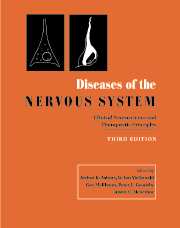Book contents
- Frontmatter
- Dedication
- Contents
- List of contributors
- Editor's preface
- PART I INTRODUCTION AND GENERAL PRINCIPLES
- PART II DISORDERS OF HIGHER FUNCTION
- PART III DISORDERS OF MOTOR CONTROL
- PART IV DISORDERS OF THE SPECIAL SENSES
- 41 Smell
- 42 Taste
- 43 Disorders of vision
- 44 Oculomotor control: normal and abnormal
- 45 Disorders of the auditory system
- 46 Vertigo and vestibular disorders
- PART V DISORDERS OF SPINE AND SPINAL CORD
- PART VI DISORDERS OF BODY FUNCTION
- PART VII HEADACHE AND PAIN
- PART VIII NEUROMUSCULAR DISORDERS
- PART IX EPILEPSY
- PART X CEREBROVASCULAR DISORDERS
- PART XI NEOPLASTIC DISORDERS
- PART XII AUTOIMMUNE DISORDERS
- PART XIII DISORDERS OF MYELIN
- PART XIV INFECTIONS
- PART XV TRAUMA AND TOXIC DISORDERS
- PART XVI DEGENERATIVE DISORDERS
- PART XVII NEUROLOGICAL MANIFESTATIONS OF SYSTEMIC CONDITIONS
- Complete two-volume index
- Plate Section
43 - Disorders of vision
from PART IV - DISORDERS OF THE SPECIAL SENSES
Published online by Cambridge University Press: 05 August 2016
- Frontmatter
- Dedication
- Contents
- List of contributors
- Editor's preface
- PART I INTRODUCTION AND GENERAL PRINCIPLES
- PART II DISORDERS OF HIGHER FUNCTION
- PART III DISORDERS OF MOTOR CONTROL
- PART IV DISORDERS OF THE SPECIAL SENSES
- 41 Smell
- 42 Taste
- 43 Disorders of vision
- 44 Oculomotor control: normal and abnormal
- 45 Disorders of the auditory system
- 46 Vertigo and vestibular disorders
- PART V DISORDERS OF SPINE AND SPINAL CORD
- PART VI DISORDERS OF BODY FUNCTION
- PART VII HEADACHE AND PAIN
- PART VIII NEUROMUSCULAR DISORDERS
- PART IX EPILEPSY
- PART X CEREBROVASCULAR DISORDERS
- PART XI NEOPLASTIC DISORDERS
- PART XII AUTOIMMUNE DISORDERS
- PART XIII DISORDERS OF MYELIN
- PART XIV INFECTIONS
- PART XV TRAUMA AND TOXIC DISORDERS
- PART XVI DEGENERATIVE DISORDERS
- PART XVII NEUROLOGICAL MANIFESTATIONS OF SYSTEMIC CONDITIONS
- Complete two-volume index
- Plate Section
Summary
Vision is the primary sensory input to the brain in terms both of the number of sensory fibres and in the amount of cortical processing area devoted to its analysis. As a consequence there is a protean number of disorders, which range in their pathophysiological mechanisms from disturbed axon conduction, as in optic neuritis, to the abnormal cortical sensory processing apparent in the generation of visual hallucinations. The localization of visual disturbances is often assisted by appropriate analysis and interpretation of visual field defects (Fig 43.1).
Anterior visual pathway
Disorders of the optic nerve
Optic neuritis
Optic neuritis (ON) is a term used to describe an idiopathic optic neuropathy or one resulting from inflammatory, infectious or most commonly demyelinating etiology. In the majority of cases the optic disc is normal on ophthalmoscopy and the term retrobulbar neuritis is used. In those cases in which the optic disc is swollen then the terms papillitis or anterior ON are used.
Clinical features
In typical ON there is usually acute unilateral loss of visual acuity and visual field, which may progress over hours or a few days, reaching its maximal impairment within 1 week. Ninety per cent of cases complain of ocular pain which is noted especially with eye movement, and which may precede the visual impairment by a few days (Lepore, 1991). The visual loss may range from contrast defects with maintained acuity to no light perception. A defect of colour vision is almost universal. Although ON is generally associated with a central scotoma a wide variety of field defects may be found ranging from a central scotoma to altitudinal and nerve fibre layer defects (Keltner et al., 1993). An afferent pupillary defect is present in over 90% of patients with acute ON. The patient is usually aged under 40 years, although ON may occur at any age, and improvement takes place in most patients (90%) to normal or near normal visual acuity over several weeks. There may be persistent subtle residual defects of colour vision, depth perception and contrast sensitivity, which may continue for several months. Subsequent disc pallor may occur but does not correlate closely with the level of visual recovery (McDonald & Barnes, 1992).
ON exemplifies a number of the pathophysiological consequences of axonal demyelination, which may be partial or complete.
- Type
- Chapter
- Information
- Diseases of the Nervous SystemClinical Neuroscience and Therapeutic Principles, pp. 621 - 633Publisher: Cambridge University PressPrint publication year: 2002

